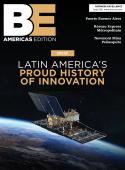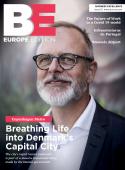A study in design┬áCleveland State University is engaged in an ambitious program of construction and renovation. Ed Schmittgen explains to Gay Sutton how the work is enriching student life and enhancing academic capabilities. Universities are continually searching for new ways to attract, engage and retain students. Academic reputation, of course, plays an essential part in this, but so too does the whole life-enriching experience that the student environment provides. This has resulted in a building boom of academic, residential and student life-oriented facilities at many institutions. ┬áOver the past six years, Cleveland State UniversityÔÇölocated in the heart of downtown Cleveland and with perhaps the highest proportion of postgraduate students in the whole of OhioÔÇöhas spent over $200 million on construction projects. The aim is to create exactly this ÔÇ£wow factorÔÇØ to beguile visitors, enhance academic capabilities and enrich student life. In charge of the development program is director of capital planning Ed Schmittgen, an architect by trade.┬áPerhaps the most impressive and monumental undertaking of the entire development program is a $54 million plan to demolish the old University Center at the very heart of the campus and construct a new Student Center designed by renowned New York architect Charles Gwathmey. ÔÇ£The old building was effectively 80,000 square feet larger than we needed,ÔÇØ says Schmittgen, ÔÇ£and the difference in cost between renovating a 200,000-square-foot building and constructing a new 120,000-square-foot one turned out to be about $5 million. So we decided to go for a brand new, purpose-built, LEED-certified facility that would be dedicated purely to the students.ÔÇØ┬á When it opens in May 2010 it will be the first building dedicated exclusively to students in the history of the university. With beautiful, prominent spaces and rooms for student administration, welfare and so on, it will include a bookstore and dining facilities and will be the heart of student life. ÔÇ£But in the meantime, the decision represented a two-and-a-half-year commitment to having the center of campus ripped apart,ÔÇØ Schmittgen explains. Demolition of the old building began in May 2008, and construction work began in September of that year. Although the demolition took place largely while the students were away, ÔÇ£we had expected many complaints,ÔÇØ Schmittgen says. The University Center was, after all, situated in the middle of campus. ÔÇ£But it was such a spectacle that everybody was totally mesmerizedÔÇöpeople would stand on the street and just watch.ÔÇØ Another major project just five months ahead of the Student Center is the construction of a $37 million College of Education. Designed by NBBJ from Columbus. This three-story, 100,000-square-foot building will provide dedicated faculty offices, technology labs and teaching classrooms for the College of Education and for Human ServicesÔÇöall of which have previously been scattered around the campus. ÔÇ£This college will be their first real identity.ÔÇØ Other projects under way at the moment include the multiphase construction of a 600-bed residential block and a $12 million parking garage for approximately 600 cars, to be completed later this year.The university has not restricted itself to new construction, though. A great deal of effort has gone into renovating some of the existing campus buildings. ÔÇ£The university was founded in 1964 and saw its main building boom between 1968 and 1973,ÔÇØ Schmittgen explains. ÔÇ£The architectural style at the time was what we call ÔÇÿbrutalism.ÔÇÖ Most of our older campus buildings are of gray concrete or limestone and are elevated onto a plaza, which is a very defensive gesture.ÔÇØ One of the aims of the program is to reverse the gray defensive image created by the ÔÇÖ60s and ÔÇÖ70s concrete structures. ÔÇ£We hope to make the campus friendlier, more approachable and more welcoming by paying attention to color, texture and scale.ÔÇØBuilding materials play an important role in this. Schmittgen avoids the use of concrete where he can, preferring textured materials such as brick and stone, and colors to add warmth and interest. ÔÇ£The scale of the building is also important,ÔÇØ he continues. ÔÇ£A lot of our old buildings were massiveÔÇömonumental. WeÔÇÖre trying to escape from that and create buildings that respond to the human form.ÔÇØThe Law Building, for example, has been completely transformed by a project that reached completion early in 2008. The original structure appeared as a solid and repressive 70-foot-high brick edifice, separated from the street by a 10-foot mound of earth. ÔÇ£If you walked around this earth berm, youÔÇÖd have come across a narrow passage about five feet wide that went behind the earth mound, and then youÔÇÖd discover a small entry to the building. It was absurd,ÔÇØ Schmittgen says. In a project costing $7.8 million, he removed the earth mound and has built a light and dramatic entry that is both welcoming and visually appealing.Meanwhile, the main classroom block has also undergone a major $28 million renovation and opened to students in August 2008. ÔÇ£It was a monster of a building,ÔÇØ Schmittgen says. ÔÇ£The ground level was primarily open air, with an auditorium, six classrooms and a monumental stair, and it was completely inappropriate to our climate. We enclosed the whole lower level and rebuilt it. Then we tore out the west fa├ºade, built out terraces and a new stair, and enclosed the entire thing with a curvilinear glass wall. Now we have an extremely dramatic space.ÔÇ£WeÔÇÖve done an extraordinary amount of work in the last six years,ÔÇØ he continues. But according to Schmittgen, the work is not likely to stop there. Plans have just gone out to tender for a developer to build parking garages for around 900 cars for the university, and to construct and manage an area of housing that will go up around the universityÔÇÖs baseball field. ÔÇ£ItÔÇÖs very exciting and will be a great location,ÔÇØ he finishes. ÔÇ£Residents will be able to stand on their balconies and watch the baseball.ÔÇØ ÔÇô Editorial research by Jim Rose┬á









